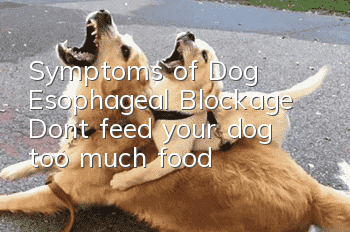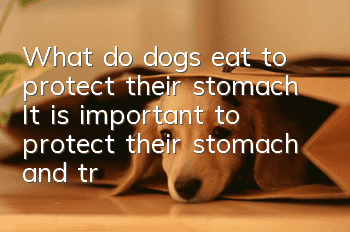Symptoms of Dog Esophageal Blockage Don’t feed your dog too much food!

Esophageal infarction refers to a problem caused by food or other foreign objects blocking the esophagus. It is a situation that is more likely to occur in dogs' daily life. Because dogs themselves are relatively fast, they may increase their eating speed again once they are stimulated or affected. So it is best to arrange a quieter place to feed the dog.
Common causes of esophageal infarction in dogs
1. Irregular eating or underfeeding makes the dog overly hungry, eating too fast, swallowing large mouthfuls of food without fully chewing it, or eating Being disturbed, suddenly raising the head, swallowing, etc.2. Being naughty and accidentally eating gloves, wooden blocks and other indigestible foreign objects.
3. I don’t usually feed dog food. I like to feed chicken bones, fish bones and other small bones, which cause them to get stuck in the dog’s throat.
4. Esophageal infarction can occur in any part of the esophagus, but it is most likely to occur at the chest entrance of the esophagus, at the bottom of the heart and into the esophageal hiatus.
Symptoms of esophageal obstruction in dogs
1. When incomplete esophageal infarction occurs suddenly, the sick dog will experience slight restlessness, vomiting and choking, eating slowly, not eating large pieces of food (meat, bones), difficulty swallowing, and pain.
2. When there is complete infarction or obstruction by sharp foreign objects, the dog will suddenly refuse to eat, be highly restless, straighten the head and neck, drool a lot, choke or vomit, spit out foamy mucus and blood, and often scratch its hind limbs. Scratching the neck, coughing, or even suffocation. Generally, the dog at this time is unwilling to eat, whether it is water or food. In such cases, it is necessary to send the dog to the hospital for examination as soon as possible.
Prevention and treatment of esophageal obstruction in dogs
The diagnosis can be made based on the dog's medical history and sudden special symptoms, combined with gastric tube probing to find the obstruction. X-ray fluoroscopy can determine its specific location.1. Feeding must be carried out regularly and quantitatively, do not be overly hungry, and prevent uneven hunger. It is best to choose a quiet place to feed the dog to prevent human interference.
2. Pay more attention to your dog’s movements and try to keep easily swallowed foreign objects out of reach of your dog. You can also do some training to get your dog to hand over items.3. Do not feed bones from chickens, ducks, fish and other animals to dogs. These bones are relatively soft and small and can easily get stuck in the dog’s throat after being swallowed. If you want to feed bones, you can choose large leg bones from cattle, sheep, and pigs for your dog to chew on and grind his teeth at the same time.
4. Mild infarction often recovers after repeated choking or spasmodic swallowing, when the obstruction is spit out or enters the stomach on its own.
5. Most require treatment. Oral liquid white wax or vegetable oil, followed by subcutaneous injection of pilocarpine nitrate (pilocarpine nitrate) a few hours later, can cure the disease.
6. You can also use a thin gastric tube to carefully push the foreign body into the stomach after taking liquid paraffin.7. If it gets stuck in a relatively close position later, we can try to take it out ourselves. ButIf the location is deep and the jam is severe, then it needs to be sent to the hospital for treatment. It is usually necessary to anesthetize the dog before removing it.
- How to tell if your dog is fat? Is your dog overweight?
- Will your dog catch a cold if you blow the air conditioner? What should you do if your dog catches a cold if you blow the air conditioner?
- The dog's mouth bites and shakes. Why does the dog's mouth occasionally shake and bite?
- How to cut a dog's hair? Do you know how to cut a dog's hair correctly?
- Can dogs eat raw eggs? Why can’t dogs eat egg whites?
- Common Dog Problems in Summer How to Deal with Different Dog Problems
- How to keep dogs away from skin diseases. If you do this, will you see if your dog will still be infected with skin diseases?
- What causes anorexia in dogs? Dogs will become anorexic due to lack of exercise. Hounds run at least 5KM every day.
- Can dogs eat liver? What should you pay attention to when giving liver to your dog?
- Can canine herpes virus be transmitted to humans? Owners should not be too nervous



